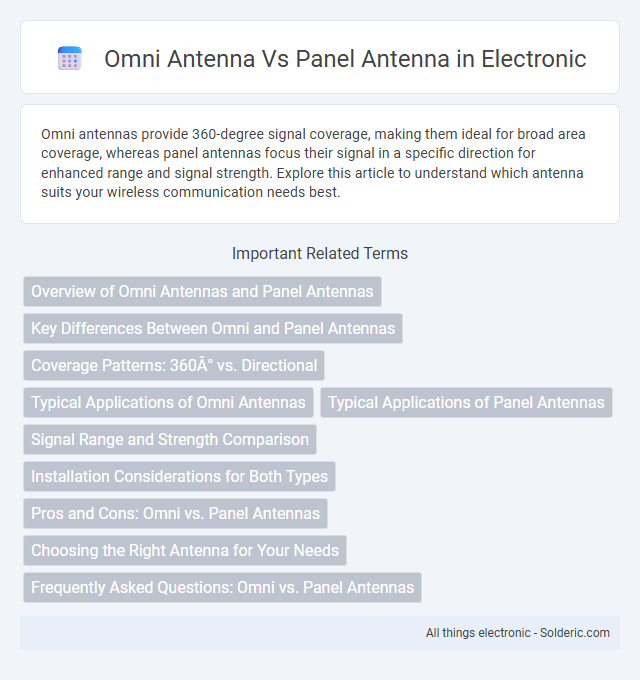Omni antennas provide 360-degree signal coverage, making them ideal for broad area coverage, whereas panel antennas focus their signal in a specific direction for enhanced range and signal strength. Explore this article to understand which antenna suits your wireless communication needs best.
Comparison Table
| Feature | Omni Antenna | Panel Antenna |
|---|---|---|
| Radiation Pattern | 360deg horizontal coverage, omnidirectional | Directional with a focused beam, typically 60deg to 120deg |
| Coverage Area | Wide area, ideal for surrounding environments | Targeted area coverage, suited for specific directions |
| Gain | Low to moderate (2-8 dBi) | Higher gain (8-18 dBi) |
| Use Case | General coverage, mobile and multipoint systems | Point-to-point links, focused coverage in buildings or sectors |
| Installation | Simple, usually mounted vertically | Requires alignment towards target direction |
| Interference | More prone due to 360deg reception | Less interference due to directional design |
| Typical Applications | Wi-Fi hotspots, cellular base stations, IoT deployments | Indoor coverage, sectorized cellular sites, fixed wireless |
Overview of Omni Antennas and Panel Antennas
Omni antennas provide 360-degree horizontal coverage, making them ideal for applications requiring broad, uniform signal distribution such as in urban areas or indoor environments. Panel antennas focus signal transmission in a specific direction with a narrow beamwidth, enhancing range and signal strength for point-to-point or sector coverage in cellular networks. Both antenna types vary in gain, size, and deployment scenarios, influencing their suitability for diverse wireless communication needs.
Key Differences Between Omni and Panel Antennas
Omni antennas provide 360-degree signal coverage, making them ideal for broad-area communication, while panel antennas offer focused, directional signals with higher gain for targeted coverage. Omni antennas are commonly used in environments requiring signal distribution in multiple directions, such as urban areas or large indoor spaces, whereas panel antennas are preferred for point-to-point communication or sector-specific coverage in cellular networks. The key differences lie in their radiation patterns, gain levels, and deployment scenarios, influencing their suitability for either widespread connectivity or focused signal strength.
Coverage Patterns: 360° vs. Directional
Omni antennas provide a 360-degree coverage pattern, ideal for broad, uniform signal distribution in areas requiring widespread connectivity. Panel antennas deliver a directional coverage pattern, concentrating signal strength in a specific direction to extend range and improve performance. Selecting between omni and panel antennas depends on the need for comprehensive area coverage versus targeted signal enhancement.
Typical Applications of Omni Antennas
Omni antennas are typically used in applications requiring 360-degree horizontal coverage, such as mobile communication base stations, Wi-Fi hotspots, and IoT device networks. Their ability to provide uniform signal distribution makes them ideal for environments like urban areas, public parks, and large indoor spaces where broad, multi-directional connectivity is essential. These antennas excel in scenarios that demand consistent signal strength across all directions without the need for signal focusing.
Typical Applications of Panel Antennas
Panel antennas are commonly used in point-to-point communication systems, cellular base stations, and Wi-Fi networks due to their directional radiation patterns that provide focused signal coverage and increased range. They are ideal for targeting specific areas or sectors, enhancing signal strength and reducing interference in dense environments such as urban locations and office buildings. Their ability to offer high gain and narrow beamwidth makes them essential for applications requiring precise signal direction and improved network capacity.
Signal Range and Strength Comparison
Omni antennas provide 360-degree signal coverage, making them ideal for broad area communication, but their signal strength diminishes with increased distance due to the wide dispersion. Panel antennas concentrate the signal in a specific direction, offering stronger signal strength and greater range within their focused beam, which enhances connectivity over longer distances. Your choice depends on whether you need extensive coverage or targeted signal power for optimal wireless performance.
Installation Considerations for Both Types
Omni antennas require central placement for 360-degree coverage and often demand higher mounting points to optimize signal propagation. Panel antennas need precise directional alignment toward target areas, making installation more complex but allowing focused signal strength and reduced interference. Both types must consider environmental factors like obstructions and mounting hardware compatibility to ensure optimal performance.
Pros and Cons: Omni vs. Panel Antennas
Omni antennas provide 360-degree coverage, ideal for broad area signal distribution but may suffer from interference and limited range. Panel antennas focus signals in a specific direction, offering greater range and signal strength but require precise alignment for optimal performance. Your choice depends on whether you prioritize widespread coverage or targeted, long-distance connectivity.
Choosing the Right Antenna for Your Needs
Selecting the right antenna depends on your coverage requirements and environment; omni antennas provide 360-degree signal distribution ideal for broad, general coverage, while panel antennas focus signal in a specific direction, offering higher gain and better range for targeted areas. Your choice should consider factors like installation location, desired coverage radius, and interference levels to maximize performance. Evaluating these needs helps ensure your network achieves optimal connectivity and reliability.
Frequently Asked Questions: Omni vs. Panel Antennas
Omni antennas provide 360-degree signal coverage ideal for wide-area applications, while panel antennas offer directional coverage, enhancing signal strength over targeted zones. Users often ask which antenna type suits better for specific environments; omni antennas excel in open areas requiring broad connectivity, whereas panel antennas are preferred in urban or indoor settings for focused coverage. Common FAQs also address installation complexity, with panel antennas typically demanding precise alignment compared to the simpler setup of omni antennas.
omni antenna vs panel antenna Infographic

 solderic.com
solderic.com